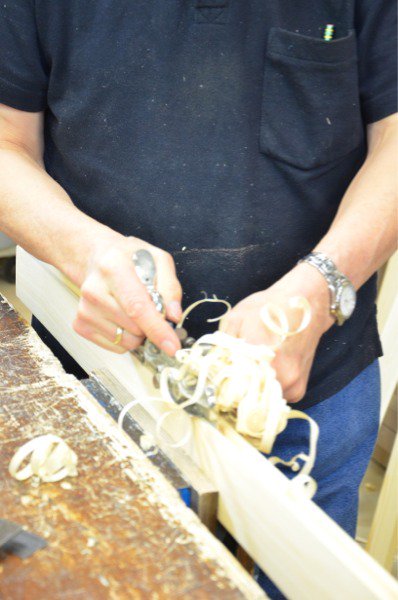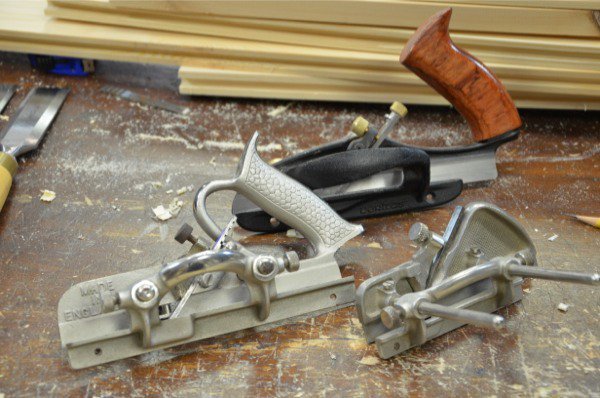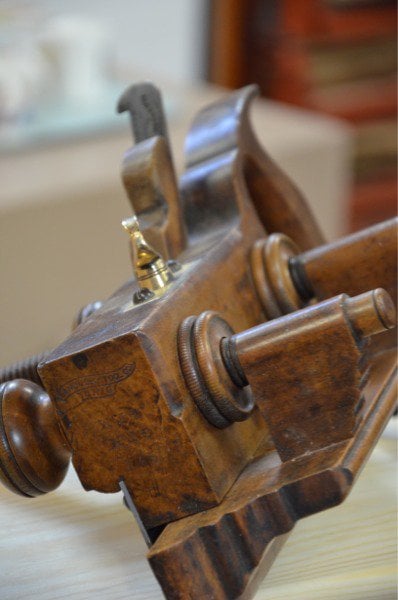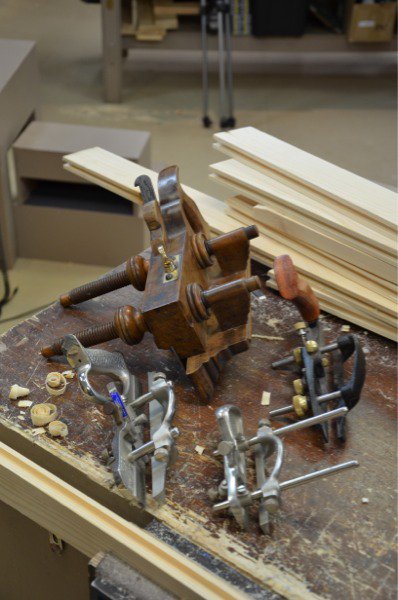How to Hold Work for Ploughing a Groove
For more information on Plough Planes, see our beginner site Common Woodworking.
Considering plough planes past and present

I have ploughed grooves for 50 years and used every type of plough plane I think. Just about any way. I'm not old fashioned, I just like the upper body exercise, the self discipline of hand work, breathing good air that isn't exhaled into a fabric mask and being able to hear clearly each stroke I take. My hands may ache just a little some times, but my body is never as tensely stressed as it is when a screaming router pulls against me and threatens my sanity and peace. The plough pulls me gently to task and somehow I enjoy uniting my senses to the cutting iron as it slices through each layer of wood. What I feel has nothing to do with nostalgia but life. My wellbeing relies on my senses being stirred and stimulated. I hear and see, smell smells I cannot smell by any other means,and my tongue tastes the essence of the wood I work by being transferred through the air. Friction becomes critical to this, but who understands what takes place when I rive and split, saw, plane and chop. I feel oak differently than cherry and walnut differs so markedly from pine and yew and ash. Green wood too has distinctive smells and sounds as I work the fibres.
The reason I like plough planes is because they work their way so readily into the wood no matter the wood I work. The irons are narrow, not like smoothing planes, and so I can plough wood taking shavings four times thicker than when I smooth wood with a smoothing plane. The grooves go down quickly for me no matter which plough plane I use. In some measure they are all my favourites really.

The Record 043 (bottom right) is punchy, compact, stoutly built and as stocky as a Haflinger. It's very direct, comfortable and vibration free no matter the grain terrain. It's quick to set up, easy to adjust and lends itself to tight control even with only one hand if needed.
The Record 044 has adjustment (left) but needs a screwdriver to set the depth. The advantage of this is the fence doesn't slip. The metal handle is more comfortable than it looks for an all metal handle though in a cold shop it takes a minute to warm in the hand and in a really cold shop robs the hand of all heat. A fingerless gloved hand takes care of this. I love this plane too and rank it as more an Arabian gelding for its flightier appearance but solid dependability. There are two or three on ebay right now. One at a buy-it-now of £45, which I consider a good and fair price because all of the parts and cutters seem to be there and condition looks nice too. There's another buy-it-now for £20 but only has one cutter so would need buying more or making them as needed. Cutting irons always come up for £3 each and free shipping. Still a good price fora working plough.
I suppose the Thoroughbred in the stable is the Veritas (top) which almost mirrors the Record 044c with refinements and a current-day increase in cost. I think it definitely equals the 044 and the 044c in the hand and the wooden handle is nice and solid.

Percherons are powerful through and through. French heavyweights used as power-filled war horses. So strong and resilient, unfaltering in tackling awkward grains; handling any and all woods. That's the old, wooden, handled plough plane. I bought this Sandusky plough a couple of years ago and since then i have enjoyed using it as well and as much as any other. My Marples screw-stem handled version will always be my favourite amongst the ploughs, but I like using this one too.
Today I ploughed the grooves in the back frame of my bookcase using the plough. It took about three-quarters of an hour of vigorous work but it wasn't hard work particularly. The working height of 40" is as perfect as it can be. Very direct to my arm and shoulder-line thrust.

The difference between these four ploughs I used today is minimal. The wooden Sandusky is the best and lightest in use even though the plane weighs more than all the others. That's the effect of wood on wood. Near frictionless motion makes a big difference. I don't know of any modern day planemaker making wooden ploughs, but if they did copy a Sandusky like this one they would sell them readily. provided they could match the quality of the Sandusky. This took skilled work and was the primary reason for the demise of the wooden plough plane. In every step toward industrialized production came a reduction in the need for quality skilled workers who could work the more refined areas of plane making. The all metal planes take minimal skill to make. Bolt on, bolt in components for assembly-line production using a series of engineering processes meant lower cost products, reduced skill sets and faster manufacture. With diminished skill levels, the plane making process replaced the highly skilled work of the plane maker irreversibly and nowhere is this seen more than in the making of plough planes.
How to Hold Work for Ploughing a Groove
Source: https://paulsellers.com/2014/01/plough-planes-ploughing-just-thoughts/